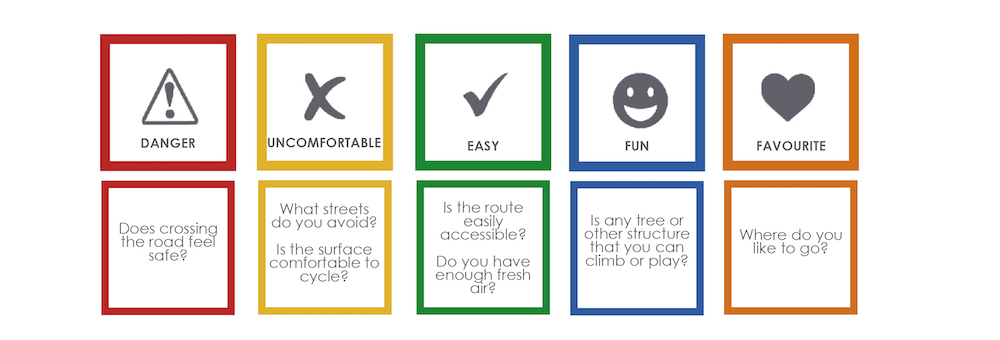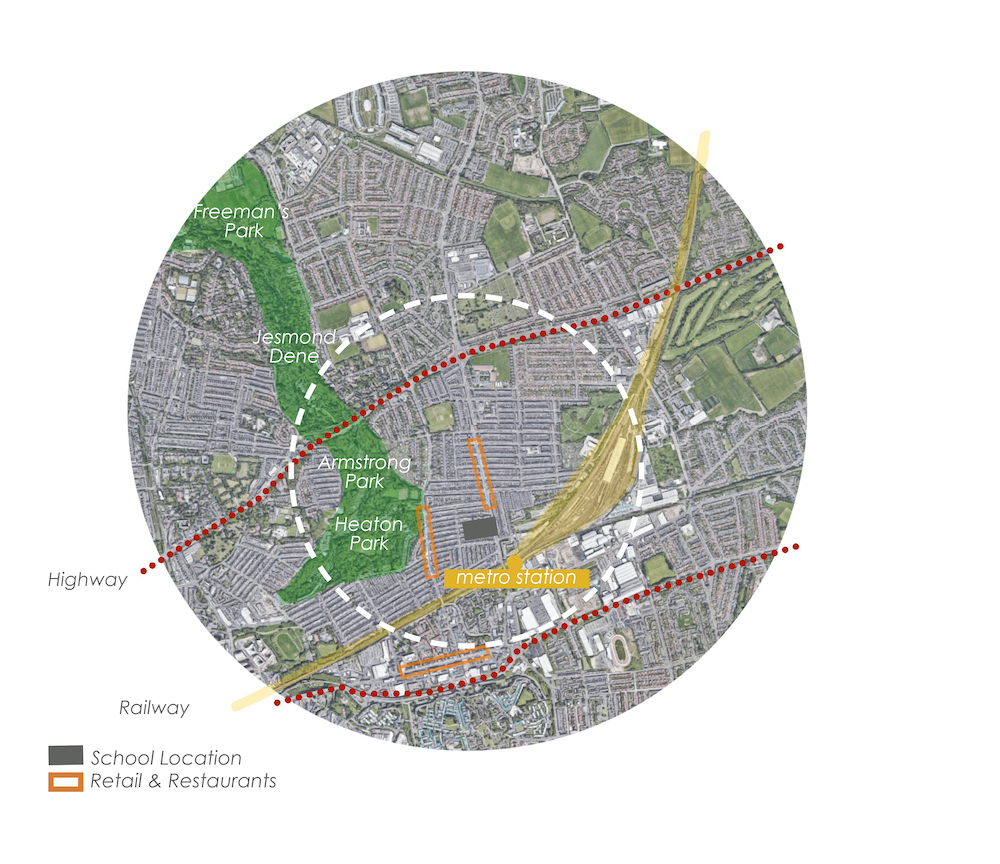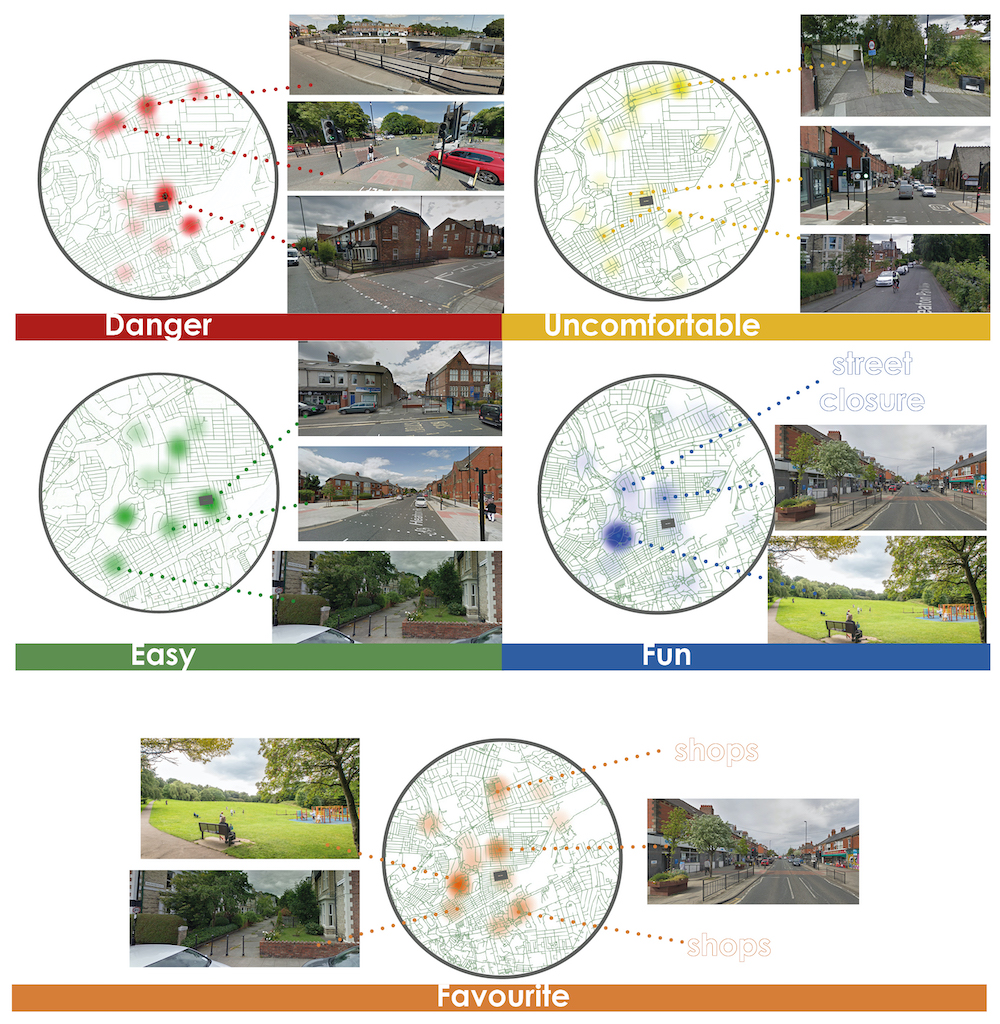Public health / Healthy Cities
Active communities: Children’s experiences of the social and physical neighbourhood on their journeys to school
By Nafsika Michail, Dr Ayse Ozbil Torun, Dr Rosie Parnell and Dr Kyung Wook Seo | 04 Feb 2021 | 0
This paper describes a study based on a number of participatory map-based focus groups with year 5 children (aged 9-10), with the aim of exploring how they experienced their journey to school and identify their perceptions of neighbourhood design.
Authors of scientific paper:
Abstract
Active school travel (AST) can provide an inclusive opportunity for physical activity and shape healthy behaviours among children. Children’s affective experience of their everyday travel may influence their travel decisions, however, there is limited evidence about children’s preferences and experiences regarding their journey to school.1,2 Being in the middle of a pandemic with fewer opportunities for playing outdoors, it’s urgent to understand how we should design the built environment towards safe neighbourhoods for active children.
This study is based on a number of participatory map-based focus groups with year 5 children (aged 9-10) carried out between November 2019 and March 2020 in four primary schools located in Newcastle upon Tyne. The aim was to explore how children experienced their journey to school and identify their perceptions of neighbourhood design. Using qualitative geographic information system (GIS) software to analyse the results of participatory mapping with children, this paper demonstrates the places children indicated as fun, easy, uncomfortable, dangerous or favourite. Enablers and barriers to children’s engagement in public space are explored. Places providing opportunities for social interaction are found to be children’s most favourite spaces, while safety regarding traffic or other people’s activities emerged as a barrier to AST and playing outdoors.
The novel participatory approach and qualitative analysis employed in this study have the potential to contribute to the growing but limited body of research on children’s perceptions about environments supportive of physical and social activity. Insight into children’s experiences could inform urban planners, designers and health professionals how to apply more effective behaviour change interventions, targeting an increase in active school travel among children.3 Understanding children’s needs could support a post pandemic rethinking and designing of streets and public spaces that enable physically and socially active children and communities.
Keywords
Taking into consideration the increased number of children who are born and raised in urban environments and the role of urban form on promoting physical activity, healthy diet and the quality of air, it’s clear that the impact of urban environments on children’s health and quality of life is crucial. It’s therefore important to target the planning and design of cities that provide the best possible conditions for children’s health and development. At the same time, children are part of the community and they have the right to be part of the planning and design process of the places in which they live.
More specifically, with only 39 per cent of primary school pupils walking to school and 6 per cent using scooters and bikes,4 childhood obesity rates in Newcastle upon Tyne are significantly higher than the average in England and above the North East average.5 Similarly, 32 per cent of boys and 35 per cent of girls in Newcastle upon Tyne get to exercise outside school only once per week, while 13 per cent have no opportunity for physical activity.4 Hence, active school travel (AST) could provide an opportunity for physical activity6 and shape healthy behaviours.7 In addition, AST could be an effective public health intervention as it can target large-scale populations and is inclusive.8
Nonetheless, apart from increasing the level of physical activity, AST can benefit children’s mental development,9 promote socialising, support children’s sense of freedom,10 and provide opportunities for children to explore their localities and be part of their local community.11 During the middle of a pandemic there are limited opportunities for playing outdoors, and cars are seen as a safer means of getting around in order to maintain social distancing. Active and safe streets that promote AST are therefore more critical than ever.
Previous research indicates that more children may walk or cycle to school if they had the choice.12 However, there is limited evidence about children’s preferences and experiences regarding their journey to school.1,2 Designers and policy makers need to urgently understand how to design the built environment to be supportive of active children through the creation of safe neighbourhoods. Behaviour science suggests that travel behaviour is both habitual and reasoned.13 That means that cognitive, behavioural and affective attitudes may affect travel behaviour decisions.14 Therefore, understanding children’s affective experiences could help urban designers and planners design better places that may promote active travel behaviours, and encourage sustainable behaviour change.
Methods
This study is based on a number of participatory map-based focus groups with year 5 children (aged 9-10) carried out between November 2019 and March 2020 in four primary schools in Newcastle upon Tyne. The aim was to explore how children experienced their journey to school and identify their perceptions of neighbourhood design. Only three to four children participated in each group to ensure time and space for everybody to share their experiences and opinions. In addition, children from the same part of the neighbourhood were grouped together to ensure that all members of the groups were familiar with similar places, which helped them develop rich discussions around places and streets.
For each group, an A0 high-resolution Google map was provided. To make the process more playful and engaging, five coloured prompt cards were provided for children, describing five different feelings: danger, uncomfortable, easy, fun, favourite (see figure 1).15 Same colour stickers could be used by the pupils to indicate places where they may have an experience similar to the feelings of the cards. They were encouraged to justify the reason(s) of using a sticker in a specific place, which led to discussions between the members of the group. The discussions were voice recorded.

Following the focus groups and participatory mapping, the stickers were geocoded in QGIS. The recordings were transcribed and the comments related to each sticker were organised into attribute tables according to the five feelings identified by the prompt cards. By geocoding the stickers it was easier to identify the density of the stickers that may overlap in the same place,2 while the attribute tables ensures the geocoding process is more qualitative.
For the scope of this paper, only the findings of one of the primary schools (see figure 2) are presented. Twenty-three children participated in six focus groups. Ethics approval was granted by the Ethics Committee of Northumbria University.

Results
The results are illustrated in figure 3.

Dangerous – Children mentioned their worries around big and busy streets: ‘… (about Coast Road) It always worries me, cause it’s such a big road.’ A child characterised a big roundabout on the north of the school as ‘… super bad’, while the most red stickers were in a crossing close to school: ‘I know! I know! Μy mum always says you never allowed to cross this road by yourself because you can be run over.’ Nonetheless, apart from roads and crossings, many children refer to the metro station as a dangerous place, mainly because of the existing anti-social behaviour that they’re faced with at this site: ‘I think people keep following me when I’m going to the metro and I feel people always looking at me.’
Uncomfortable – Busy roads in terms of traffic were uncomfortable for children, mainly because of the noise pollution: ‘The Coast road is very annoying, especially at night when you’re trying to sleep, just so many cars.’; ‘I live in Heaton Road and there are too many cars I hear and it’s not good.’ Pavement parking is also uncomfortable to children: ‘There are loads of cars like actually on the pavement, and it’s just like this narrow, you can’t get through.’ However, the most uncomfortable place is an underground pedestrian crossing under a highway, in the north of the school: ‘I don’t want to go over there. But it’s like the only way to get to your house by walking.’ In addition, the metro was also identified as an uncomfortable place, mainly because it’s crowded: ‘Metro, because I’m not really a fan of lots of people and sometimes it’s a little unsafe because I don’t get a seat.’ Finally, broken glasses, associated with anti-social behaviour, is an uncomfortable element of the built environment: ‘You can’t really see and you step on the broken glasses on the floor.’
Easy – The most popular place that children found easy was ‘… the street outside the school’ and places where there is a dedicated cycle path and lots of space to cycle and play: ‘I have an easy one along that road because there’s a cycle path along here,’; ‘... It’s easy to ride bikes here – there is a path in Heaton Park for cycling with a massive field for playing.’ Some of them who reside in the south-west part of the area found the pedestrian road in between their houses easy: ‘Easy, easy, easy, it’s very easy to walk,’; ‘... it’s like just pavement and then a road in the middle. We have like five metres long where you play, with lamp posts, bollards.’ Furthermore, children may refer to the street outside their house as an easy one: ‘I would say it’s here, cause that’s our road.’
Fun – The local park, Heaton Park, collected the most fun stickers from the children among all focus groups: ‘The park is fun cause I can play with my dog all day and meet friends there,’; ‘At one point our class went for pizza picnic there.’ Similarly, some of the pupils living in the northern part of the area mentioned the street outside their houses as fun when it’s closed to car traffic as a play street: ‘Mine is my street in summer, since we live on the streets next to each other and some streets are open for play and kids come out to play.’ Finally, shops are fun for children, especially when they can buy sweets or food, and it’s an activity connected with a member of the family: ‘Tesco, cause I used to go to get croissants with my dad, and the blue shop where I go with my sister to get sweets.’
Favourite – Shops: ‘Greggs!’, ‘Sainsbury’s’, parks: ‘I like Heaton park! Because inside there is no car’; ‘Cause I always meet friends there.’ And places where children have fun are their favourite places: ‘The swimming pool!’; ‘I’m going to put both fun and favourite here.’ However, “favourites” stickers were distributed on the map, because children used them to indicate their houses as well: ‘Cause it’s my house and there are always staff there and my bed. My bed and food!’; ‘My house where my cat is.’
Discussion
Insight into children’s experiences could inform urban planners, designers and health professionals how to apply more effective behaviour change interventions, targeting an increase in AST among children.3 For this study, focus groups were conducted with primary school pupils to identify the barriers and enablers to AST, according to children’s affective experiences.
According to children, “danger” is mainly associated with large busy roads in terms of traffic, large-scale infrastructures (eg, ring road and underpass), and unsafe crossing points. However, places may also be characterised as dangerous because of anti-social behaviours (such as broken glass). Similarly, “uncomfortable” is associated with cars and underground infrastructures, as well as with crowded places and broken glasses in the street. Children’s affective attitudes indicate that both physical and social environment may discourage them to walk or cycle to school and that they might associate active school travel with non-pleasant experiences.
On the other hand, “easy” places are associated with streets, parks and cycling paths but also with places where children feel familiar with, such as the streets outside the school or outside their houses, highlighting the importance of a consistent community. Similarly, “fun” places are where they can play and socialise (eg, having sweets with their family and friends). The findings indicate that the built environment cannot be separated from the social environment for children when it comes to fun places. Spacious and safe places shared with friends and family constitute the fun places where they enjoy themselves, since these spaces provide opportunities to socialise, share and be active. The integral correlation between the built and social environment for children’s experiences is more noticeable in the identification of their “favourite” places. Their homes, streets, school and local places, which they feel familiar with and where they meet their friends and family and play safely, are regarded by children as their favourite places.
In summary, based on children’s affective attitudes, the findings of this study show that places that feel familiar to children and provide safe urban conditions to play, walk, cycle and meet friends and family are considered positively (ie, fun, favourite, easy) by children aged 9-10. Hence, it can be argued that these spaces may enable active travel and physical activity among children. It’s then important from a design and planning perspective to create neighbourhoods and places that can support active relationships between the communities, and provide safe open public spaces for children. Understanding children’s needs could support post-pandemic rethinking, and designing of streets and public spaces that enable physically and socially active children and communities.
About the authors
Nafsika Michail is a PhD student at the Department of Built Environment and Architecture, Northumbria University, where Dr Ayse Ozbil Torun is an associate professor. Dr Rosie Parnell is professor of architecture and pedagogy at the School of Architecture, Planning & Landscape, Newcastle University. Dr Kyung Wook Seo is associate professor at the Department of Built Environment and Architecture, Northumbria University.
References
- Egli, V, Mackay, L, Jelleyman, C, Ikeda, E, Hopkins S, and Smith, M, Social relationships, nature, and traffic: Findings from a child-centred approach to measuring active school travel route perceptions. Children’s Geographies; 2019. https://www.tandfonline.com/doi/abs/10.1080/14733285.2019.1685074?journalCode=cchg20
- Wilson, K, Coen, SE, Piaskoski, A, Gilliland, J. Children’s perspectives on neighbourhood barriers and enablers to active school travel: A participatory mapping study. The Canadian Geographer / Le Geographe canadien, 63(1): 112-128; 2019. https://onlinelibrary.wiley.com/doi/full/10.1111/cag.12488
- Mitra, R. Independent mobility and mode choice for school transportation: A review and framework for future research. Transport Reviews, 33 (1): 21-43; 2013. https://www.tandfonline.com/doi/abs/10.1080/01441647.2012.743490
- Schools Health Education Unit. Newcastle Children and Young People’s Health and Wellbeing Survey; 2019. Available from: http://www.servicestoschools.org.uk/Page/7404 [Accessed on 24 March 2020]
- Public Health England. Patterns and trends in child obesity in the North East; 2020. Available from https://www.gov.uk/government/publications/child-obesity-patterns-and-trends [Accessed on 24 March 2020]
- Carver, A, Barrb, A, Singh, A, Badland, H, Mavoa, S, Bentley, R. How are the built environment and household travel characteristics associated with children’s active transport in Melbourne, Australia? Journal of Transport & Health, 12: 2019, 115-129; 2019.
- Schoeppe, S, Duncan, MJ, Badland, HM, Oliver, M, and Browne, M. Associations between children’s active travel and levels of physical activity and sedentary behavior. Journal of Transport & Health, 2 (3): 336-342; 2015. https://www.sciencedirect.com/science/article/abs/pii/S2214140515002182
- Oliver, M, Parker, K, Witten, K, Mavoa, S, Badland, HM, Donovan, P, Chaudhury, M, and Kearns, RA. Children’s out-of-school independently mobile trips, active travel, and physical activity: A cross-sectional examination from the kids in the city study. Journal of Physical Activity & Health, 13 (3): 318-324; 2016.
- Singh, A, Uijtdewilligen, L, Twisk, JWR, et al. Physical activity and performance at school. A systematic review of the literature including a methodological quality assessment. Arch Pediatr Adolesc Med. 2012; 166(1): 49-55; 2012. https://pubmed.ncbi.nlm.nih.gov/22213750/
- Waygood, EOD, Friman, M, Olsson, LE, and Taniguchi, A. Children’s incidental social interaction during travel international case studies from Canada, Japan, and Sweden. Journal of Transport Geography, 63: 22-29; 2017.
- Ross, NJ. My journey to school … : Foregrounding the meaning of school journeys and children’s engagements and interactions in their everyday localities. Children’s Geographies, 5 (4): 373-391; 2007.
- Larouche, R, and Tranter, P. ‘Conclusions’, in Larouche, R. (Ed). Children’s active transportation. Canada: Elsevier, 259-266; 2018.
- Murtagh, S, Rowe, DA, Elliott, MA, McMinn, D, and Nelson, NM. Predicting active school travel: The role of planned behavior and habit strength. International Journal of Behavioral Nutrition and Physical Activity; 9:65; 2012.
- Garcia, J, Arroyo, R, Mars, L, and Ruiz, T. The influence of attitudes towards cycling and walking on travel intentions and actual behavior. Sustainability, 11(9), 2554; 2019. https://doi.org/10.3390/su11092554
- Derr, V, Chawla, L, Mintzer, M. Putting it together and taking action. In Derr, V, Chawla, L, Mintzer, M. (Ed). Placemaking with children and youth: Participatory practices for planning sustainable communities. New York: New Village Press, 277-328; 2018.
Further reading
- Lubans, DR, Boreham, CA, Kelly, P, et al. The relationship between active travel to school and health-related fitness in children and adolescents: A systematic review. Int J Behav Nutr Phys Act, 8, 5; 2011. https://doi.org/10.1186/1479-5868-8-5
- McCurdy, LE, Winterbottom, KE, Mehta SS, Roberts, JR. Using nature and outdoor activity to improve children’s health. Current Problems in Pediatric and Adolescent Health Care, 40:6, 156; 2010.
- Mendoza, AJ, Watson, K, Nguyen, N, Cerin, E, Baranowski, T, and Nicklas, AT. Active commuting to school and association with physical activity and adiposity among US youth. Journal of Physical Activity and Health, 8: 4, 488-495; 2011. https://doi.org/10.1123/jpah.8.4.488
Organisations involved

